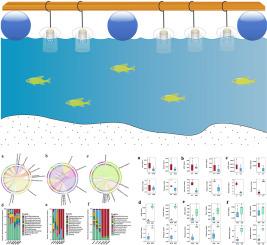微塑料对水产养殖生态系统微生物多样性和病原体分布的影响:季节性分析
IF 7.3
2区 环境科学与生态学
Q1 ENVIRONMENTAL SCIENCES
引用次数: 0
摘要
微塑料作为海洋环境中一种突出的新兴污染物,由于其抗生物降解性,对海洋生态系统的稳定性构成了严重威胁。MPs作为生物污垢的底物,可能促进有害微生物的传播。研究表明,人类活动加剧了水产养殖环境中MPs的污染,显著增加了它们的丰度。本研究对大黄鱼(Larimichthys crocea)的养殖环境进行了研究。大黄鱼是沿海地区最广泛养殖的鱼类之一。我们对覆盖MPs的生物膜及周围养殖水体的微生物多样性进行了全面分析,重点研究了MPs上病原菌的分布。此外,本研究还研究了季节变化对这些生物膜内微生物群落的影响。测序结果显示,冬季MPs表面微生物群落α-多样性低于养殖水体,而夏季则高于养殖水体,说明MPs表面微生物群落结构存在季节性变化。PICRUSt预测表明,MPs上的微生物具有独特的代谢途径。共现网络分析表明,夏季MPs上微生物群落的连通性和功能模块化增强,而冬季养殖水体中微生物群落的相互作用增强。此外,在MPs生物膜中检测到几种潜在的病原体,包括弧菌和假单胞菌。这些发现强调了MPs影响水产养殖环境中微生物群落结构的方式,增加了对生态系统的健康风险。本研究对MPs污染对水产养殖生态系统微生物群落的生态影响提供了重要的见解。本文章由计算机程序翻译,如有差异,请以英文原文为准。


Impact of microplastics on microbial diversity and pathogen distribution in aquaculture ecosystems: A seasonal analysis
Microplastics, as a prominent emerging pollutant in marine environments, pose a serious threat to the stability of marine ecosystems due to their resistance to biodegradation. MPs act as substrates for biofouling and potentially promote the spread of harmful microorganisms. Research indicates that human activities exacerbate MPs pollution in aquaculture environments, significantly increasing their abundance. This study focused on the aquaculture environment of the large yellow croaker (Larimichthys crocea), one of the most extensively farmed fish species in coastal regions. We conducted a comprehensive analysis of microbial diversity on the biofilms covering MPs and in the surrounding aquaculture water, with a focus on the distribution of pathogens on MPs. Furthermore, this study investigated the impact of seasonal variations on the microbial communities within these biofilms. Sequencing analysis revealed that the α-diversity of microbial communities on MPs was lower than that in aquaculture water during winter but higher in summer, indicating a seasonal shift in microbial community structure. PICRUSt predictions suggested that microbes on MPs possess unique metabolic pathways. Co-occurrence network analysis demonstrated that during summer, the microbial communities on MPs revealed increased connectivity and functional modularity, whereas microbial communities in aquaculture water showed stronger interactions in winter. Additionally, several potential pathogens, including Vibrio and Pseudomonas, were detected in the MPs biofilms. These findings underscore the ways in which MPs influence the microbial community structure in aquaculture environments, increasing health risks to the ecosystem. This research offers significant insights into the ecological impacts of MPs pollution on microbial communities in aquaculture ecosystems.
求助全文
通过发布文献求助,成功后即可免费获取论文全文。
去求助
来源期刊

Environmental Pollution
环境科学-环境科学
CiteScore
16.00
自引率
6.70%
发文量
2082
审稿时长
2.9 months
期刊介绍:
Environmental Pollution is an international peer-reviewed journal that publishes high-quality research papers and review articles covering all aspects of environmental pollution and its impacts on ecosystems and human health.
Subject areas include, but are not limited to:
• Sources and occurrences of pollutants that are clearly defined and measured in environmental compartments, food and food-related items, and human bodies;
• Interlinks between contaminant exposure and biological, ecological, and human health effects, including those of climate change;
• Contaminants of emerging concerns (including but not limited to antibiotic resistant microorganisms or genes, microplastics/nanoplastics, electronic wastes, light, and noise) and/or their biological, ecological, or human health effects;
• Laboratory and field studies on the remediation/mitigation of environmental pollution via new techniques and with clear links to biological, ecological, or human health effects;
• Modeling of pollution processes, patterns, or trends that is of clear environmental and/or human health interest;
• New techniques that measure and examine environmental occurrences, transport, behavior, and effects of pollutants within the environment or the laboratory, provided that they can be clearly used to address problems within regional or global environmental compartments.
 求助内容:
求助内容: 应助结果提醒方式:
应助结果提醒方式:


